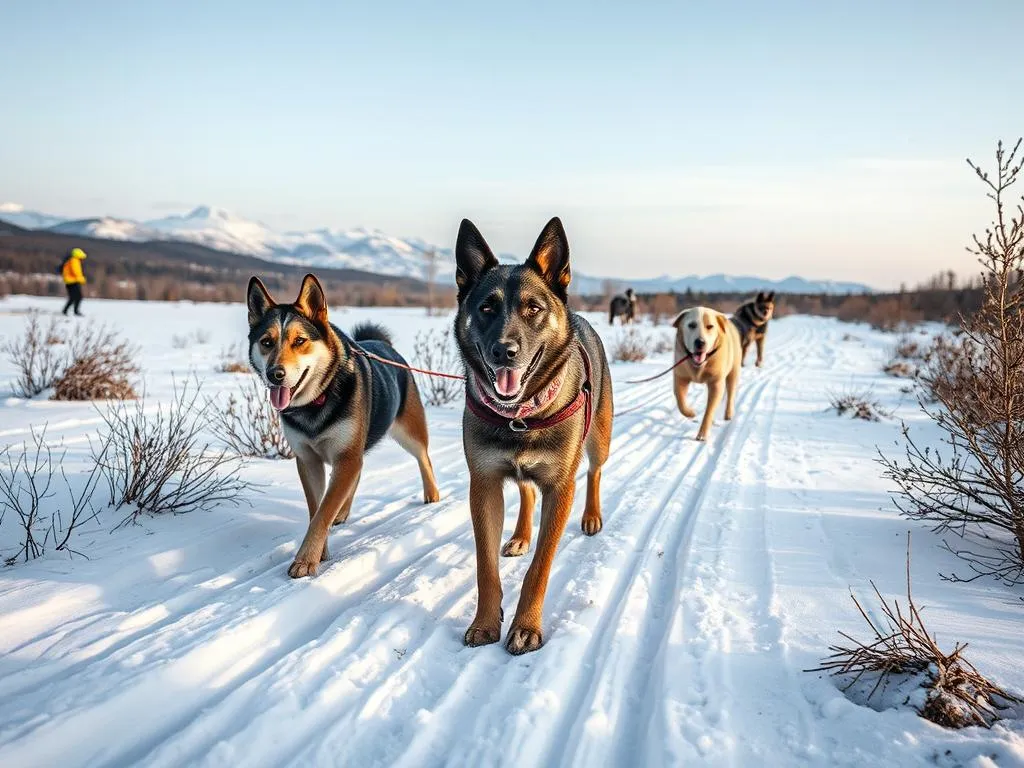
Introduction
Skijoring with dogs is an exhilarating winter sport that combines the thrill of skiing with the joy of working alongside our four-legged companions. This unique activity has been gaining popularity, allowing dog owners to enjoy the great outdoors while bonding with their pets. Essentially, skijoring involves a skier being pulled by a dog that is harnessed to them, creating a dynamic partnership. The bond between the skier and their dog is crucial, as it enhances the experience and ensures both parties are in sync and enjoying the ride. Here’s everything you need to know about skijoring with dogs, from choosing the right equipment to training techniques and safety considerations.
Understanding Skijoring
History of Skijoring
Skijoring has its roots in Scandinavia, where it was originally developed as a means of transportation across snowy terrains. The term itself comes from the Norwegian words “ski” (to glide on snow) and “kjøring” (to drive). Over the years, the sport has evolved, transitioning from a practical mode of travel to a popular recreational activity. It gained significant traction in North America during the 20th century, particularly in areas with heavy snowfall. Today, countless enthusiasts partake in skijoring events, showcasing their skills and enjoying the thrill of the sport.
The Basics of Skijoring
Before diving into the adventure, it’s essential to understand the basics of skijoring with dogs. The primary equipment needed includes:
- Skis: Choose a pair of lightweight, durable skis that suit your skiing style.
- Harness for the dog: A specialized dog harness is crucial for comfort and control.
- Towline: This connects the harness to the skier, allowing for a safe and efficient pull.
- Other Accessories: Protective gear such as helmets and goggles for the skier, and booties for the dog to protect their paws from harsh conditions.
Skijoring works by creating a dynamic partnership between the skier and the dog. As the dog pulls, the skier glides along, relying on the dog’s strength and energy. This teamwork not only enhances the experience but also fosters a deep bond between the dog and its owner.
Choosing the Right Dog for Skijoring
Ideal Breeds for Skijoring
Not all dogs are suited for skijoring with dogs. Certain breeds excel in this sport due to their energy levels, strength, and natural instincts. Ideal breeds include:
- Siberian Huskies: Known for their endurance and strength, they are natural pullers.
- Alaskan Malamutes: These dogs are powerful and have a strong desire to run.
- German Shorthaired Pointers: Agile and energetic, they make excellent skijoring companions.
- Labrador Retrievers: Friendly and eager to please, they adapt well to many activities.
The ideal dog for skijoring should possess certain traits, such as high energy levels, a strong build, and a willingness to work alongside their owner.
Assessing Your Dog’s Fitness Level
Before embarking on a skijoring adventure, it’s vital to assess your dog’s fitness level. Just like humans, dogs require physical conditioning to participate in physical activities. Check for the following:
- Physical Condition: Your dog should be at a healthy weight and have a good level of fitness.
- Readiness for Skijoring: Consider your dog’s age, breed, and health. Consult your veterinarian if uncertain.
- Signs of Overexertion: Be aware of fatigue, excessive panting, or limping. These are indicators that your dog may be overexerted and needs a break.
Essential Gear for Skijoring
Skijoring Equipment
Having the right equipment is critical for a successful and safe skijoring experience. Key items include:
- Skis: Opt for longer, lightweight skis that provide stability and control.
- Dog Harness: Choose a harness that fits correctly and is designed for pulling.
- Towline: Look for a durable, elastic towline that can absorb shocks and provide flexibility.
- Safety Gear: Helmets for the skier and booties for the dog are essential for protection.
When selecting gear, consider brands known for their quality, such as Ruffwear for dog harnesses and Fischer or Salomon for skis.
Preparing Your Dog
Proper preparation of your dog is crucial for a successful skijoring outing. Make sure to:
- Fit the Harness: Ensure that the harness fits snugly but comfortably to avoid chafing or injury.
- Acclimatize Your Dog: Allow your dog to get used to the harness and towline before hitting the trails. Start with short walks and gradually increase the distance.
- Training: Basic training is essential. Teach your dog commands such as “Go,” “Stop,” “Left,” and “Right” to ensure effective communication during your skijoring adventure.
Training for Skijoring
Basic Commands for Skijoring
Training your dog to respond to commands is vital for a safe and enjoyable skijoring experience. Key commands include:
- Go: A command to start moving forward.
- Stop: Essential for halting your dog’s movement.
- Left/Right: Commands to guide your dog in the desired direction.
To teach these commands effectively, use positive reinforcement techniques such as treats and praise. Consistency is key; practice regularly to reinforce learning.
Building Endurance and Stamina
Gradually building your dog’s endurance and stamina is essential before hitting the slopes. Consider the following training exercises:
- Short Runs: Start with short distances, gradually increasing the length as your dog adapts.
- Interval Training: Incorporate bursts of speed followed by rest periods to enhance fitness.
- Warm-Up and Cool-Down: Always include warm-up exercises to prevent injury and cool-down routines to help your dog recover.
Safety Considerations
Choosing Safe Locations
Selecting the right location for skijoring with dogs is crucial for safety. Ideal terrains include:
- Groomed Trails: Look for well-maintained trails that are free from obstacles.
- Flat Terrain: Beginners should start on flat, open areas before attempting more challenging slopes.
- Check Trail Conditions: Always check the weather and trail conditions to ensure a safe experience.
Health and Injury Prevention
Preventing injuries is vital for both you and your dog. Keep the following in mind:
- Common Injuries: Be aware of injuries such as sprains, strains, and paw pad injuries. Regular breaks can help mitigate these risks.
- Vet Check-ups: Ensure your dog receives regular veterinary check-ups and vaccinations to stay healthy.
- Hydration and Nutrition: Hydrate your dog before, during, and after skijoring. Ensure they have a balanced diet to support their activity levels.
Skijoring Etiquette and Community
Understanding Trail Etiquette
Respecting trail etiquette is essential for enjoying skijoring with dogs. Follow these guidelines:
- Share the Trail: Be mindful of other trail users, including skiers and snowshoers. Always yield to those on foot.
- Control Your Dog: Keep your dog under control to ensure the safety of all trail users.
Joining a Skijoring Community
Connecting with fellow skijorers can enhance your experience. Consider these benefits:
- Support and Advice: Join local clubs or online communities to learn from experienced skijorers and share your experiences.
- Events and Competitions: Participate in local events and competitions to test your skills and meet like-minded individuals.
Conclusion
Engaging in skijoring with dogs is not only an excellent way to enjoy winter sports but also a fantastic opportunity to strengthen the bond with your furry companion. By understanding the essential equipment, training techniques, and safety considerations, you can embark on thrilling adventures together. As you explore the snowy landscapes, remember to be responsible and respectful within the skijoring community. Embrace the joy of this sport, and may your journeys be filled with fun and camaraderie!









